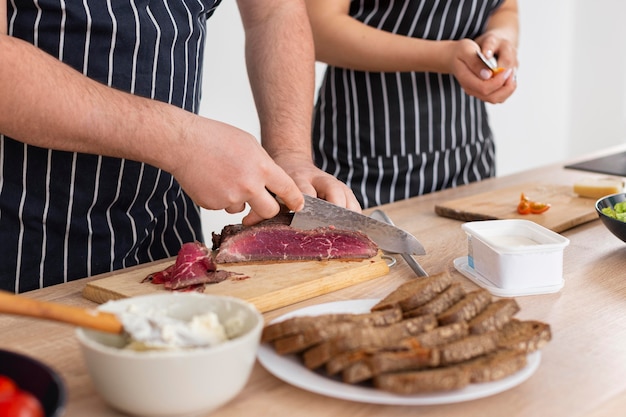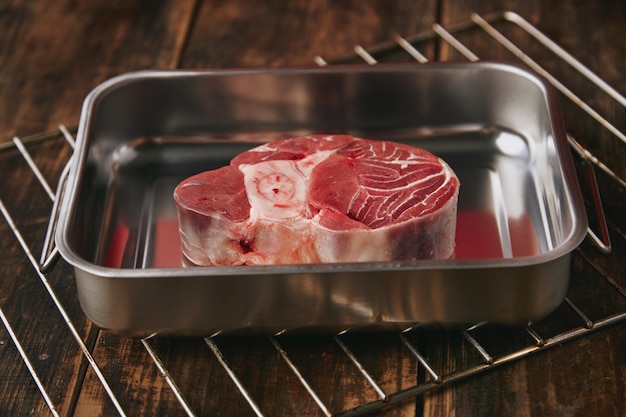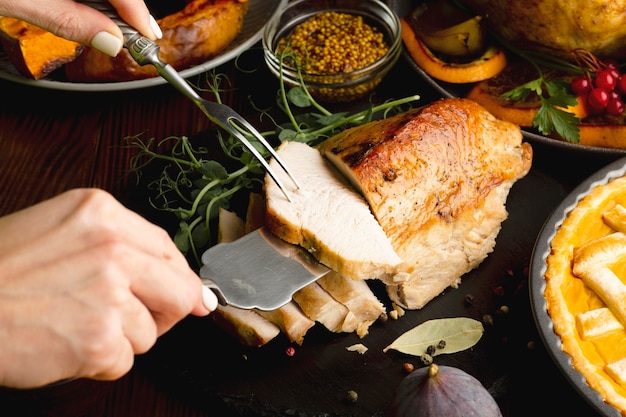Let's be honest, a perfectly roasted pork tenderloin is a culinary triumph. It's that tender, juicy, and flavourful dish that everyone loves, whether it's a fancy dinner party or a simple weeknight meal. Over the years, I've roasted countless pork tenderloins, and I've learned a thing or two about what makes them truly exceptional. This guide is my love letter to the oven-roasted pork tenderloin, a compilation of tips, tricks, and recipes that will help you create something truly special.
(Part 1) Choosing the perfect pork tenderloin: The Foundation of Flavor

Finding the Right Cut: It's Not Just Any Tenderloin
When it comes to pork tenderloin, not all cuts are created equal. You want a tenderloin that's firm to the touch, boasts a healthy colour, and is free of any bruises or discoloration. The colour should be a light pink, indicating freshness. Don't be afraid to ask your butcher for guidance; they're a wealth of knowledge and will help you choose the perfect cut. Remember, a good butcher is your culinary sidekick, and they're always happy to share their expertise.
I once found myself in a predicament, looking for a tenderloin for a big dinner party and feeling overwhelmed by the choices. My local butcher came to the rescue, helping me select the perfect cut. He even offered some invaluable tips on cooking it, boosting my confidence in the kitchen. It's those little touches that make all the difference.
Size Matters: Scaling It to Your Needs
The size of your tenderloin directly impacts how many people you can feed. For a smaller gathering, a single tenderloin will suffice. But if you're cooking for a crowd, consider getting two. Alternatively, you can divide a larger tenderloin into two portions to ensure even cooking. Aim for a thickness of 1 to 1.5 inches. This ideal thickness guarantees even cooking and prevents the tenderloin from drying out. We all know that a dry, tough pork tenderloin is a culinary tragedy.
(Part 2) Prepping Your Pork Tenderloin: Setting the Stage for Success

The Salt Game: The Secret to Tenderness and Flavor
Salt is the unsung hero of a delicious pork tenderloin. Many people think a quick sprinkle before roasting is enough, but let me tell you, that's a recipe for disaster. You need to salt your tenderloin properly, and that means using the right amount and allowing it to sit for a while. Salt draws out moisture, yes, but it also draws moisture back in as the meat rests, resulting in tenderization and an explosion of flavour. It's a bit of culinary alchemy, really.
The ideal time to salt is at least 30 minutes before cooking, but 2-4 hours is even better. Use kosher salt, sea salt, or a combination of both. Just ensure it's high-quality salt. Don't be afraid to experiment with different salts. I once used a flaky sea salt, and the texture of the salt crystals added a unique dimension to the dish. It was a revelation!
Seasoning It Right: A Symphony of Flavor
Now, let's talk about seasoning. I'm a firm believer in keeping things simple with freshly ground black pepper and a sprinkle of paprika. But feel free to unleash your creativity! Experiment with other spices like garlic powder, onion powder, thyme, rosemary, or even a pinch of cayenne pepper for a bit of heat. Don't be afraid to embrace your inner chef and create your own flavour profile. I once added a blend of dried herbs and spices, and the results were incredible. The flavours just danced on my tongue, a culinary symphony in my mouth.
The Importance of Resting: A Moment of Relaxation
Here's a critical step that often gets overlooked: resting your pork tenderloin after cooking. Allow it to rest for about 10 minutes before slicing. This gives the juices time to redistribute throughout the meat, resulting in incredibly tender and flavorful results. Cover it loosely with foil and let it rest on a cutting board. It's like giving the meat a chance to relax and recover from the cooking process. Use this time to grab a glass of wine and enjoy the anticipation of the delicious meal to come. It's a well-deserved moment of relaxation.
(Part 3) Oven-Roasting Your Pork Tenderloin: A Step-by-Step Guide

Preheating is Key: Setting the Stage for Success
Preheat your oven to 400 degrees Fahrenheit (200 degrees Celsius). Preheating is essential for achieving that beautiful golden-brown crust that makes your pork tenderloin irresistible. While the oven is warming up, let's set up the roasting pan. I prefer using a roasting pan with a rack to elevate the tenderloin, preventing it from sitting in its own juices and promoting even cooking. It's all about creating the perfect environment for your tenderloin to shine.
Getting Your Tenderloin Ready: A Few Quick Steps
Place your seasoned pork tenderloin on the rack in the roasting pan. If you're using a large tenderloin, consider cutting it in half. Ensure there's enough space around the tenderloin for air to circulate, enabling even cooking. It's like giving your tenderloin a little breathing room.
Time for Roasting: The Culinary Countdown
Now, slide your tenderloin into the preheated oven and roast for about 20-25 minutes, or until an instant-read thermometer inserted into the thickest part registers 145 degrees Fahrenheit (63 degrees Celsius). Don't worry, mastering the perfect roast takes practice, so feel free to check the temperature a few times during the cooking process. A meat thermometer is your best friend, ensuring your pork is cooked to the right temperature and safe to eat. You can find meat thermometers at most supermarkets and kitchen stores. It's a small investment that pays off big time when it comes to food safety.
The Finishing Touch: A Moment of Rest
Once the pork tenderloin is cooked, remove it from the oven and let it rest for 10 minutes. This allows the juices to redistribute, making the meat incredibly tender and juicy. Cover the tenderloin loosely with foil while it rests. When it's time to serve, slice the pork tenderloin into thick pieces and enjoy the fruits of your labor. You've created a culinary masterpiece.
(Part 4) Mastering the Perfect Roast: Tips and Tricks for Elevating Your Game
Using a Thermometer: Your Culinary Compass
I can't emphasize enough the importance of using a meat thermometer. It's your culinary compass, guiding you towards the perfect temperature and ensuring your pork is safe to eat. Aim for an internal temperature of 145 degrees Fahrenheit (63 degrees Celsius). This ensures the pork is cooked through without becoming dry or tough. It's all about finding that perfect balance of doneness.
Don't Overcook It: A Lesson in Patience
Pork tenderloin is a lean cut of meat, making it susceptible to overcooking. If you overcook it, it becomes dry and tough. Check the temperature regularly and take it out of the oven when it reaches 145 degrees Fahrenheit (63 degrees Celsius). It's better to err on the side of slightly undercooked than overcooked, as it's always easier to cook it a bit more if needed. Patience is key, my friend.
The Power of Basting: Adding Layers of Flavor
Basting your pork tenderloin during roasting adds a layer of richness and tenderness that elevates the dish. I love a simple mixture of butter, olive oil, and herbs. You can also use pan juices or a mixture of wine and broth. The key is to baste every 15-20 minutes during the cooking process. Each basting adds moisture and flavor, resulting in a tenderloin that practically melts in your mouth.
Embrace the Glaze: The Finishing Touch
Want to take your pork tenderloin to the next level? Try glazing it with a delicious sauce or glaze in the last 15-20 minutes of cooking. I'm a big fan of a simple honey-soy glaze, but feel free to experiment with different flavor combinations. A good glaze adds a beautiful shine and a burst of flavor to your pork tenderloin. I often use a combination of honey, soy sauce, ginger, and garlic, but you can also use store-bought glazes or create your own. Just be sure to brush it onto the tenderloin in the last few minutes of cooking, allowing the glaze to caramelize for a beautiful, glossy finish. It's the perfect way to cap off your culinary masterpiece.
(Part 5) Delicious Variations on the Classic Oven-Roasted Pork Tenderloin: Beyond the Basics
Lemon and Herb Pork Tenderloin: A Burst of Freshness
This classic combination is a crowd-pleaser. Simply rub the pork tenderloin with a mixture of lemon zest, fresh herbs like rosemary and thyme, and a bit of olive oil. Roast as usual and enjoy the bright citrusy flavours and aromatic herbs. It's a flavour combination that will transport you to a sunny Mediterranean garden.
Honey Garlic Pork Tenderloin: Sweet and Savory Harmony
For a sweet and savory twist, try this recipe. Mix honey, garlic, soy sauce, and a pinch of ginger for a delicious glaze. Brush the glaze onto the tenderloin in the last 15-20 minutes of cooking and let it caramelize for a beautiful, glossy finish. Serve it with a side of roasted vegetables or mashed potatoes for a comforting and satisfying meal. It's the perfect combination of sweet and savory that will leave you wanting more.
Spiced Rub Pork Tenderloin: A Flavorful Journey
Want a bit of spice? Mix together paprika, cumin, chili powder, garlic powder, and onion powder for a flavorful spice rub. Apply it generously to the pork tenderloin and roast as usual. This recipe delivers a warm, smoky flavor that's perfect for a hearty meal. It's the perfect dish for those who appreciate a little kick.
(Part 6) Serving Suggestions: Completing the Culinary Picture
Oven-roasted pork tenderloin is a versatile dish that pairs well with a wide range of sides. Here are a few of my favourites:
- Roasted Vegetables: Roasted vegetables, such as asparagus, Brussels sprouts, carrots, and potatoes, complement the pork tenderloin perfectly. The roasted vegetables provide a delightful medley of textures and flavors that create a well-balanced meal.
- Mashed Potatoes: creamy mashed potatoes are a classic comfort food that goes great with pork tenderloin. The creamy richness of the mashed potatoes is a perfect foil for the tenderloin's savory flavor.
- rice pilaf: A fragrant rice pilaf adds a nice touch of complexity to the meal. The subtle spices and nutty flavor of the rice pilaf create a contrasting element to the pork tenderloin.
- Green Salad: A fresh green salad with a light dressing helps to balance out the richness of the pork tenderloin. The salad provides a refreshing touch and adds a burst of vitamins and minerals to your meal.
Sauce It Up: Adding a Touch of Magic
Don't forget the sauce! You can serve your pork tenderloin with a delicious gravy, pan sauce, or even a fruity chutney. I often make a simple pan sauce by deglazing the roasting pan with some wine or broth, and then thickening it with cornstarch or flour. It's a great way to use the flavorful juices from the pork tenderloin. The sauce adds another dimension of flavor and moisture to the dish, making it even more satisfying.
(Part 7) Leftovers: A Delicious Second Act
Let's be honest, there's usually some leftover pork tenderloin. And that's a good thing because it's absolutely delicious the next day! Slice it up and add it to salads, sandwiches, or even use it to make a hearty soup or stew. It's also great cold, so you can even use it for snacking. It's a versatile ingredient that can be used in a variety of dishes.
(Part 8) Tips for Storing Leftovers: Keeping the Flavor Intact
To keep your leftover pork tenderloin fresh and delicious, store it in an airtight container in the refrigerator for up to 3-4 days. You can also freeze leftover pork tenderloin for up to 2-3 months. Just be sure to thaw it completely in the refrigerator before reheating. Freezing and thawing can affect the texture of the meat, so it's best to thaw it slowly in the refrigerator.
(Part 9) FAQs: Addressing the Big Questions
Q: How long should I roast a pork tenderloin?
A: roasting time depends on the size of the tenderloin, but generally, it takes about 20-25 minutes for a 1-1.5-inch thick tenderloin. Always check the internal temperature with a meat thermometer to ensure it's cooked to 145 degrees Fahrenheit (63 degrees Celsius). It's better to err on the side of caution and ensure the pork is cooked to the right temperature.
Q: What is the best way to reheat leftover pork tenderloin?
A: You can reheat leftover pork tenderloin in the oven, microwave, or skillet. For the oven, preheat to 350 degrees fahrenheit (175 degrees Celsius) and reheat for about 10-15 minutes. For the microwave, heat on high for 1-2 minutes, or until heated through. For the skillet, heat a little olive oil over medium heat and cook the pork for about 2-3 minutes per side, or until heated through. Each method has its own advantages and disadvantages, so choose the one that best suits your needs.
Q: Can I freeze pork tenderloin?
A: Yes, you can freeze pork tenderloin. Wrap it tightly in plastic wrap or aluminum foil, and then place it in a freezer-safe bag. It can be frozen for up to 2-3 months. Just be sure to thaw it completely in the refrigerator before cooking. Freezing and thawing can affect the texture of the meat, so it's best to thaw it slowly in the refrigerator.
Q: What happens if I overcook pork tenderloin?
A: If you overcook pork tenderloin, it will become dry and tough. So, make sure to check the internal temperature with a meat thermometer and take it out of the oven when it reaches 145 degrees Fahrenheit (63 degrees Celsius). It's always better to err on the side of undercooked than overcooked, as it's always easier to cook it a bit more if needed. Patience is key, my friend.
Q: How do I tell if pork tenderloin is cooked through?
A: The best way to tell if pork tenderloin is cooked through is to use a meat thermometer. It should register 145 degrees Fahrenheit (63 degrees Celsius) in the thickest part. You can also check the color of the meat. Cooked pork tenderloin should be a light pink color throughout. If it's a darker color, it may be overcooked.
There you have it! That's my ultimate guide to oven-roasted pork tenderloin. It's a simple yet delicious dish that's perfect for any occasion. Now go forth and impress your friends and family with your culinary skills! Happy cooking!
Everyone is watching

How to Cook Frozen Lobster Tails Perfectly: A Step-by-Step Guide
RecipesLobster. Just the word conjures up images of lavish meals, special occasions, and a taste of luxury. But let's...

Pork Fillet Cooking Time: How Long to Cook It Perfectly
RecipesPork fillet, or tenderloin as it's sometimes called, is a real favourite in our house. It's so versatile, and...

Pigs in a Blanket Cooking Time: How Long to Bake for Perfect Results
RecipesAh, pigs in a blanket. Just the name conjures up images of those delightful little parcels of crispy pastry en...

The Ultimate Guide to Cooking Delicious Frankfurters
RecipesLet's face it, we all love a good frankfurter. It's a classic, simple, and always satisfying. But let's be rea...

Wolf Meat Recipes: A Guide to Cooking Wild Game
RecipesLet's be honest, you don't see wolf meat at your local butcher shop every day. It's a bit of a wild card, but ...
